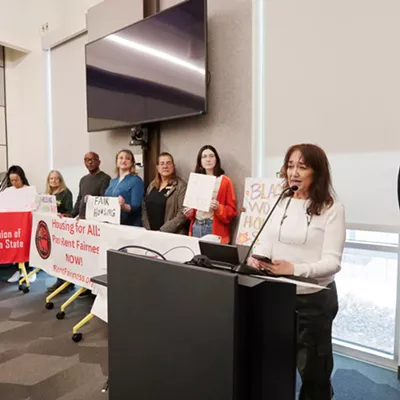The Corner Gallery in Boswell Hall at NIC offers the haunting, impressionistic works of Ashland, Ore., artist BETTY LA DUKE for just one more week in the exhibit "Africa: Between Myth and Reality." A cultural researcher as well as a visual artist, La Duke's extensive travels to Africa, China, Latin America, Borneo and India go back five decades. She has written six books devoted to multiculturalism, ecology, feminism and the ability to express one's truths through art. Although La Duke, who will be at the Corner Gallery on Sept. 12 for the closing of the show, is no stranger to many parts of the world, it is Africa that inspires the work of her show.
"Beginning in 1986, I've gone back to Africa every single year," says La Duke. "The pieces in the show are from the earlier years in the late-1980s."
Mali, Cameroon, Nigeria and Kenya were the specific sites for the work in La Duke's show.
"I was going there with the hope of working on my book projects. I wanted to explore Africa through the eyes of women artists," says La Duke. "In the process of meeting them and spending time with them, I was inspired by their cultures. I would do sketches, which was a way of bringing back a documentation to do paintings."
The myth and reality of the show's title captures the desire to be both in the moment and transcend it.
"In my work, it's important to me that I feel into the situation -- that I identify with the actual human beings before me. And there's also a sense of going beyond the moment. I found myself sometimes identifying with the energy of young boys, because they reminded me of my own son. And I also responded to the strong role models around me, the women artists I met. So that's the archetypal part.
La Duke's website, www.bettyladuke.com, shows some of her later work, interweaving angelic images with the people and traditions of her visits to Eritrea and Ethiopia.
"I try to show a cycle which has been and is and will continue," says La Duke. "It's the human condition I'm after, the war and peace and the day to day struggle of trying to coax food from the ground."
Betty La Duke's exhibit "Africa: Between Myth and Reality" shows at the Corner Gallery in North Idaho College's Boswell Hall through Sept. 12. Closing reception: Sept. 12 at 5 pm. Call: (208) 769-3277.
From a Korean Kiln
The Sheehan Gallery at Whitman College in Walla Walla runs two companion shows through the end of this month. "CROSSCUT FLAME" offers a literal cross-section of recent works fired in the Jewel Creek Anagama. What's an anagama, you wonder? As the press materials for the show assert, an anagama is "a most voracious kiln." With temperatures above 1200 & ordm; C, an anagama consumes entire cords of wood and at least several days in completing the firing process.
Collected from the Dec. 28-31, 1999, firing of the Jewel Creek Anagama on the Oregon coast, the works of the exhibit are displayed in an actual lateral cross-section of the kiln in their exact positions during firing so that visitors can see the effects of wood used, temperature fluctuations, barometric pressure, humidity and oxidation on the finished work.
"THE POET'S VITREOUS EYE" brings a selection of high-fired Korean ceramics from as early as the fourth century to light. Encompassing four dynasties and 1,500 years, the pottery is the product of hill-climbing kilns similar to the anagama, introduced by China in the fourth century. Culled from the private collection of poet Tom Crawford, the exhibit is as rare for its historical significance as it is for its artistic significance.
"Crosscut Flame" and "The Poet's Vitreous Eye" run concurrently through the rest of September at the Sheehan Gallery at Whitman College in Walla Walla. Call: (509) 527-5249.
An Eye for Invention
The Museum of Art at Washington State University has a remarkable exhibit of work by MORRIS GRAVES, who, in spite of being in his nineties, brings a futuristic sensibility to his "Instruments for a New Navigation." Roslyn Wise, assistant to the museum director, says that the show at WSU is the only one scheduled east of the Cascades.
Graves' sculptures incorporate marble, metal, glass and fossils to create forms that have a vaguely maritime feel. In fact, they resemble nothing so much as the fittings and vessels of Rand and Robyn Miller's Myst and Riven fantasy worlds.
"In addition to the sculptures, some of his works on paper will be included in the show," says Wise. "Many of these works are sculptures he designed back in the late '50s, and then did the actual construction in the '60s." Graves' gallery at the time discouraged him from showing them, finding them too eclectic for easy categorization. It wasn't until 1998 that Graves decided it was time for his instruments to see the light of day.
Also open this month at the WSU Museum of Art is "THE AMERICAN VISION," which is taken from the museum's permanent collection and works as a veritable Who's Who in American art. Some of the highlights, says Wise, are two photographs by Diane Arbus, George Inness' 1863 Evening Landscape and Thomas Hart Benton's The Music Lesson, which was given to the museum last year by John W. and Mildred Sherrod Bissinger. As in the case of the shows at North Idaho College and Whitman College, the two exhibits at Washington State University are well worth the drive.
"The American Vision" and "Morris Graves: Instruments for a New Navigation" are both on exhibit through Oct. 15 at the Museum of Art on Washington State University's Pullman campus. Opening Reception: Thursday, Sept. 14 from 6-7:30 pm in the Fine Arts Center. Call: (509) 335-1910.
















